#Flag Adoption Day history and traditions
Explore tagged Tumblr posts
Text
"National Flag Adoption Day"#trending #ytshorts #viral
Discover the importance of National Flag Adoption Day on July 22nd! This significant day celebrates the unity and history of our nation, reminding us of the values and freedoms our flag represents. National Flag Adoption Day is a moment to reflect on the sacrifices made by those who have served our country and to honour the symbol that binds us together. In this video, we delve into the history, significance, and various ways people celebrate this patriotic day. Whether you're participating in parades, attending ceremonies, or simply flying the flag, National Flag Adoption Day is a time to show your pride and gratitude. Join us as we explore the rich traditions and meanings behind this special day. Don't miss out on understanding why July 22nd holds a unique place in our hearts and in our national history.
Call: 7799799221
Website: www.manasadefenceacademy.com
#NationalFlagAdoptionDay#July22nd#FlagDayImportance#PatrioticCelebration#NationalUnity#HistoricalSignificance#ProudToBeAmerican#FlagDayTraditions#HonorOurFlag#UnityAndFreedom#traning#viral#celebrations#manasadefenceacademy
#National Flag Adoption Day July 22nd#Importance of National Flag Adoption Day#Flag Adoption Day celebration#July 22nd significance#History of National Flag Adoption Day#Patriotic events July 22nd#National unity day#Flag Adoption Day traditions#Why is National Flag Adoption Day important#National Flag Adoption Day parades#Celebrating Flag Adoption Day#Flag Adoption Day ceremonies#Honoring National Flag Adoption Day#July 22nd history#American flag day#National pride and Flag Adoption Day#Significance of July 22nd#National Flag Adoption Day activities#July 22nd patriotic day#National Flag Adoption Day meaning#Flag Adoption Day events#Importance of July 22nd#Flag Adoption Day history and traditions#National Flag Adoption Day significance#Flag Adoption Day patriotic celebration#July 22nd Flag Adoption Day#Flag Adoption Day reflections#National Flag Adoption Day symbols#Patriotic pride July 22nd#Flag Adoption Day commemorations
0 notes
Text



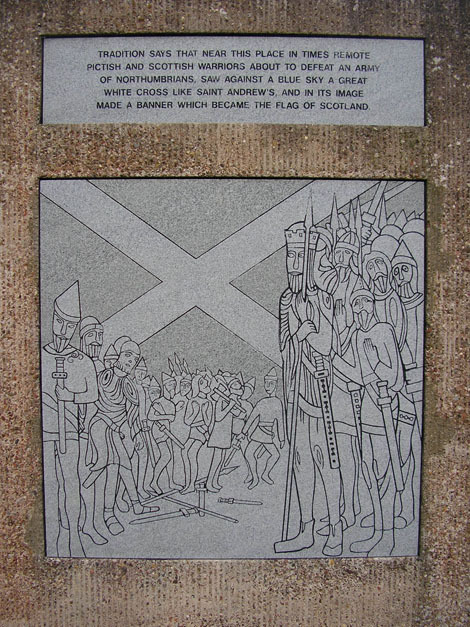
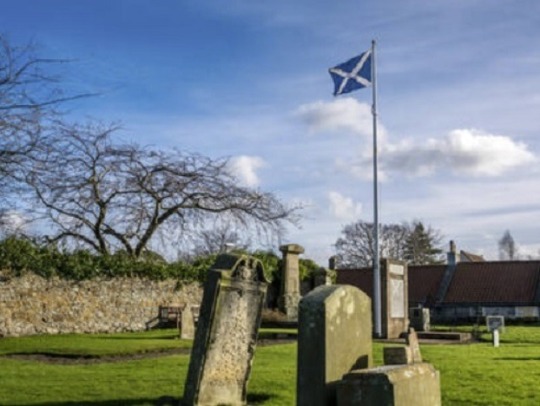
Happy St Andrews Day.
As part of our Patron Saint’s Feast Day the Scottish Saltire is proudly flown and many people add it to their posts on social media to celebrate the day, but how did Scotland adopt the saltire?
There is no actual date, or in fact nothing in our written history of the time, but legend has it that in AD 832 the king of the Picts, ‘Aengus MacFergus’, ( Anglified to Angus but some stories say Hungus) with the support of ‘Scots’ from Dalriada, won a great battle against King Athelstane of the Northumbrians. The site of the legendary battle became known as Athelstaneford in present-day East Lothian.
St Andrew visited the Pictish leader in a dream before the battle and told him that victory would be won. When the battle itself was raging, a miraculous vision of the St Andrew’s Cross was seen shining in the sky, giving a boost to the morale and fighting spirit of his warriors. The result was a victory over the Saxons, and the death of Athelstan. Thus, after this victory, according to the tradition, the Saltire or St Andrew’s Cross became the flag of Scotland, and St Andrew the national patron saint.
While there is no written reference to the battle in Scotland from the period it was said to have taken place, this is not surprising, as it was a time for which we have little or no documentation for anything. The earliest written mention of the Battle of Athelstaneford in Scottish history comes from years later in the newspapers of the day, if you follow my posts then you know I dip into these “Chronicles from time to time, the first one to mention Athelstaneford is the Scotichronicon, written by the Scottish historian Walter Bower.
The Scotichronicon has been described by some Scottish historians as a valuable source of historical information, especially for the times that were recent to him or within his own memory. But he also wrote about earlier times, and this included the battle at Athelstaneford.
Bower’s account includes the scene where Aengus MacFergus is visited by St Andrew in a dream before the battle. He was told that the cross of Christ would be carried before him by an angel, there was no mention of a St Andrew’s Cross in the sky in this version. It was in later accounts, from the 16th centuries onwards, that we have the description of an image of St Andrew’s Cross shining in the sky.
Bower was writing in the early 1400s. The bitter and bloody struggle to retain Scotland’s independence was not just a recent memory but also a current reality for him. Parts of Scotland were still occupied by England, and Bower had been involved in raising the money to release Scotland’s king, James I, from English captivity.
Also, Scotland’s early historical records and documents had been deliberately destroyed during the invasion by the English king Edward I. This was done in part as an attempt to remove historical evidence that Scotland had been an independent kingdom. The idea was simple: take away a nation’s history and you strip it of its identity and justification for its independent existence. The theft of the Stone of Destiny was part of this process, the Black Rood which was believed to contain a piece of the Cross Jesus was crucified on was also removed, I have covered both these in previous posts.
Part of Bower’s motivation in writing his Scotichronicon was to help restore this stolen history. He was a scholar and a man of the church. In his time, the figure of St Andrew had become a prominent presence in Scottish society.
The greatest church building in the land during his time was the Cathedral of St Andrew, which housed relics of St Andrew himself. It had taken over a hundred years to build and wasn’t formally consecrated until 1318, just four years after Bannockburn. The ceremony of course included Robert the Bruce and at it thanks was given to St Andrew for Scotland’s victory.
Less than 100 years after this, in 1413, the University of St Andrews was established and Walter Bower was one of its first students. By this time, the Cathedral of St Andrew was a place of pilgrimage, with thousands travelling there to venerate the saint’s relics. A pilgrimage route from the south took in the shrine of Our Lady at Whitekirk, not far from the site of the battle, and many pilgrims took a ferry across the Firth from North Berwick, where the ruins and remains of the old St Andrew’s Kirk can still be seen close to the Scottish Seabird Centre.
So as he sat down to write his history of earlier times, he was able to trace this connection to St Andrew, using the limited earlier written accounts, such as those of earlier Chronicler I’ve mentioned before, John Fordun, who lived in the 1300s. While Fordun doesn’t specifically mention the location of Athelstaneford, he records a battle which took place between the Picts led by Aengus and a force from the south led by Athelstan, and said the location of the battle was about two miles from Haddington. The account of St Andrew appearing in a dream to Aengus is also described by Fordun.
This creates a powerful link to the development of the written version of the story. Let’s remember Bower came from what is now East Lothian. Let us also remember that people in the early centuries stored and passed on much of their historical knowledge not in the written word but in memory and handed down oral traditions. People told stories, remembered them and told them to the next generation. Undeniably, some details would be forgotten or changed over time, but the bones of the story would be handed down. And that would include reference to locations of significant events in the local landscape.
Bower will have had access to this rich oral tradition of local stories based on handed-down collective memories of past events, which is perhaps why he was able to name the location. The later writers who added to the story of the battle will likewise have found new sources in the oral tradition to add to the narrative. Even in the 19th century, cartographers mapping the area were able to identify locations traditionally associated with the battle from local people who were custodians of ancestral memory.
This is how the story of the Battle of Athelstaneford and its connection with St Andrew and the Saltire has evolved.
The village is home to the National Flag Heritage Centre which occupies a lectern doocot built in 1583 and rebuilt in 1996. It is at the back of the village church. Today the village is surrounded by farmland and has little in the way of amenities. Tourists can follow the “Saltire Trail”, a road route which passes by various local landmarks and places of historical interest.
Athelstaneford Parish Kirk has a connection with the subject of my post last week, author Nigel Tranter, who was a prominent supporter of the Scottish Flag Trust. He married in the church, and in April 2008 a permanent exhibition of his memorabilia was mounted in the north transept of the church. Items include a copy of Nigel Tranter’s old typewriter, a collection of manuscripts and books, and other personal items. The display was previously at Lennoxlove House, and prior to that at Abbotsford House, the home of Sir Walter Scott.
45 notes
·
View notes
Text
11/17-18/2024 Daily OFMD Recap
TLDR; Rhys Darby; Taika Waititi; Con O'Neill; Samba Schutte; Vico Ortiz; Minnie Driver; Dominic Burgess; Anapela Polata'ivao; Brian Gattas & Connor Barrett; Nat Torress; Articles; Transgender Awarness Week; Last Chance for OFMD Buys Boats!!; Fan Spotlight: Frames for the New Unicorn; Our Flag Means Fanfiction; Love Notes;
Hey crew! Sorry it's been a bit of a week over here between work and home stuff so I'm always like 4 days behind. I'm trying to catch up and will when I can. For now, here's a big ol pile of news!
= Rhys Darby =
Well as you can probably tell Rhys is super busy at the moment! Two interviews today! Now that's overkill! You're a lunatic and I love it!
youtube
More show dates!
Aotearoa dates!
WGN - 27 MAR, Opera House
CHC - 29 Mar, Isaac Theatre Royal
AKL - 3-4 APR, Bruce Mason Centre
You can get tickets on Rhysdarby.com w/password ROBOT
for UK / Ireland Tickets:
Order tickets on Mickperrin.com w/password RDPRIORITY24

Source: Rhys' Instagram
More Daily Doodles!




Sad news Daily Doodle Fans:

Source: Rhys Darby's Free Substack
= Taika Waititi =
More Interior Chinatown interviews!
instagram
Source: TheMoviePodcast Instagram
Source: Coastal House Media
= Con O'Neill =
PSA from Con on Bsky!

Source: Con O'Neill's bsky
= Samba Schutte =
Samba attended the Hell Hath No Fury Premiere!!






Source: Samba's Instagram Stories
= Minnie Driver =
Happy 6th anniversary to Minnie and Addison (Nov 17th!)


Source: Minnie Driver Instagram
= Vico Ortiz =
Vico is on Bluesky!

Source: Vico's Bluesky (Special thanks to Chloe, aka gheyandwoke for bringing it to my attention! It's also Vico and Ane's 3 year anniversary! Congrats you two <3

Source: Vico's Instagram
More news for Vico-- they will be performing in “Tales of the Transcestors: The Divine” in the Greenway Court Theatre in CA! "Tales of the Transcestors: The Divine is a must-see World Premiere that reimagines folklore, mythologies, and spiritual guides across time and cultures. Through three interwoven stories rooted in Native Hawaiian tradition (Kapaemahu), Islamic mysticism (djinn), and spiritual alchemy (the Rebis), the production unearths personal and cultural histories to reclaim trans wisdom, healing, power, and joy. Tales of the Transcestors: The Divine captures the tension between inherited memory and lived experience, building a portal for audiences to enter a "world between worlds"—where lineage, desire, time, and space are fluid and ever-shifting."
Show Dates and Times:
Thursday December 12th - Doors: 7:30pm, Show 8pm.
Friday December 13th - Doors: 7:30pm, Show 8pm
Saturday December 14th - Doors: 2:30pm, Show 3pm - *ASL Interpreted* Show followed by Talkback
Saturday December 14th - Doors: 7:30pm, Show 8pm
Ticket information


Source: Celebrationthtr and Vico's Instagram Stories
= Anapela Polata'ivao =
Official Tinā poster is up!

Source: Tinā Film Instagram
= Brian Gattas & Connor Barrett =
I am feeling like a goober but I forgot the context of where our Hornberry and Siegfried were at! If you happen to know please let me know-- getting to see Mr. Barrett dance though really made my day!
Source: Brian Gattas Instagram Stories
= Nat Torres =
Nat once again keeping us fed with the adorable pup content.

Source: Nat Torres Instagram
= Dominic Burgess =
Dominic doesn't just collect kitties, he collects physical media as well! He was kind enough to share some of it with us! (I'm a physical media hoarder so I was excited).

Source: Dominic's Bluesky
== Articles ==
Thank you so @adoptourcrew for sharing this article from The Geekiary!

Source: Adopt Our Crew Bsky
== Transgender Awareness Week ==
The fabulous These/Thems have shared a very instructional video with out bestie Vico on the differences between cis, genderqueer and trans! Check it out below!
instagram
Source: These Thems Instagram
== Tiny Crew Big Raffle ==
More updates from OFMD Buys Boats! The raffle closes 23:59 Thursday 21st November 2024 (GMT)! So if you want to donate and enter for the raffle remember to get to it right away!



How to Enter
Source: OFMD Buys Boats Instagram
== Fan Spotlight ==
= Frames For The New Unicorn =
This beautiful collaboration by so many of our crewmates is finally up! Check out this beautiful dedication to Izzy and Con O'Neill! To learn more about the project, see the individual frames and who made them, please check out their linktr.ee!
youtube
Source: So Many Places, going with the Youtube Channel
= Other Frames Projects =
I'm waiting on permission to share.. but there's another frames project in the works! This time the moonlight scene! If you'd like to learn more you can go to Ram's Bsky Does anyone know of any other frames projects going on? I would absolutely LOVE to see something for like Oluwande, or Lucius, or Jim, or Spanish Jackie! I'm just curious if I'm missing some!
= Our Flag Means Fanfiction =
New episode of Our Flag Means Fanfiction-- and it's the #AssTonight episode! An "Oral history" (tee hee). Oh and Alex Sherman shared it on Bluesky!

Source: Our Flag Means FanFiction Instagram
== Love Notes ==
Hey there lovelies. This week has already somehow been pretty crazytown on my end, how bout yours?
I know a lot of you are going through it. I am so sorry it's so hard. This is just a gentle reminder that you are allowed to be upset, and you are allowed to be stressed or depressed. Life isn't all sunshine and rainbows, and it's okay to not be okay for a while. Please just remember that even when the darkest days are here, there is ALWAYS some light. Find some things that bring small bits of light to your life-- maybe a walk, or a special treat, a hug from a friend on or offline, or taking a moment out of your day to give someone a compliment -- whatever it is that brings that dopamine to your brain. Little things help train our brain to know that good things CAN happen, so exposing yourself to those little things day by day can help build what's sort of like a good things muscle. As more and more happen, the rough times become easier to tolerate because they are sprinkled with good things.
You are so very strong, and I know you can get through whatever you are going through. I know you don't feel like it, but you are, even when you feel your lowest. I believe in you, the crew believes in you, even if we've never spoken, we want you to be okay, okay?
Please take care of yourselves lovely, you make the world a better place by being here <3
instagram
Source: The Latest Kate's Instagram
#ofmd daily recap#daily ofmd recap#tinycrewbigraffle#rhys darby#taika waititi#minnie driver#con o'neill#dominic burgess#vico ortiz#samba schutte#our flag means fanfiction#frames for the new unicorn#Instagram#Youtube#Spotify#ofmd#our flag means death#save ofmd#adopt our crew#long live ofmd#crew4life#anapela polata'ivao#brian gattas#connor barrett
36 notes
·
View notes
Text






























Sami National Day
Sámi National Day on February 6 is a cultural celebration for the Sámi people. On this day in 1917, the first Sámi congress took place in Trondheim, Norway. The national holiday is also called ‘Samenes Nasjonaldag.’ The Sámi people, or ‘Urbefolkning’ in Norwegian, are indigenous people who live mainly in Norway, but also in Finland, Russia, and Sweden.
History of Sami National Day
On February 6, 1917, Northern and Southern Sámi people came together for the first time for a joint meeting in Trondheim, Norway. Historically crucial, the common concerns of the community were shared and addressed as they worked together to find solutions. The latest statistics estimate that 80,000 Sami people are spread across the four countries — 50,000 in Norway, 20,000 in Sweden, 8,000 in Finland, and 2,000 in Russia.
Sami National Day was created during the proceedings of the 15th Sami conference in Helsinki in 1992. As a combined minority of four countries, Sami people were looked down upon at one point in history. Many laws were forced upon them in an attempt to mold them with the general population. This led to a need for establishing a dedicated day to appreciate them. The first Sámi National Day was observed on February 6, 1993. At the same time, the United Nations proclaimed the opening of the International Year of Indigenous People in Sweden.
Ever since, this holiday has been celebrated grandly by the Sami people residing in Norway. The Sami flag is seen everywhere, and the Sami language is used to chant, sing songs, and the national anthem.
Sami National Day timeline
February 6, 1917
A Joint Meeting
The Sami people’s congress meets for the first time.
1986
The Sami Flag
An important symbol representing the Sami people, the Sami flag is approved at the 13th Nordic Sami Conference.
1992
National Celebration
The Sami National Day is adopted in Norway.
1993
First Celebration
The Sami National Day is celebrated for the first time.
Sami National Day FAQs
How do people celebrate Sami National Day?
Sami National Day is widely celebrated all over Norway and in other countries where Sami people live. The cultural significance of the day is discussed and shared especially in schools. The Sami flag is hoisted, and the national anthem is sung. Traditional food is cooked and the signature clothing of the Sami people is worn today.
How do you say Happy Sami day in Sami?
‘Lihkku Sámi Álbmotbeivviin!’
What is Sami nationality?
Sami are the indigenous people of Northern Sweden, Finland, Norway, and a small part of Russia.
How to Observe Sami National Day
Learn about the Sami people: Sami people are majorly indigenous and are relatively still considered a minority, but their culture is rich and unique. Learn about their traditions and history.
Eat ‘reinsdyrkjøtt’: Eat the popular Sami dishes on Sami National Day. Try reindeer meat, or reinsdyrkjøtt and fish.
Wear traditional clothing: What better way to get into the spirit of the day than by wearing the traditional ‘gákti’ of the Sami people? Wear traditional Sami clothing with respect for the culture and heritage.
5 Interesting Facts About The Sami Flag
Designer of the flag: Astrid Båhl from Skibotn in Norway designed the flag of the Sami people.
The color scheme is intentional: The flag’s colors, red, blue, green, and yellow, are the same as in the traditional Sami costume known as 'kolt.'
The colors are also symbolic: The colors chosen represent essentials that are important for living — red for fire, green for plants, yellow for the sun, and blue for water.
The sun and the moon: The circles on the flag represent both the sun and the moon.
Compulsory traditions: Municipal administrative buildings must fly the Norwegian flag and also the Sami flag.
Why Sami National Day is Important
It celebrates a minority group: The Sami people are well-celebrated throughout the region on this day, but it wasn’t always that way. The community has had a long history of struggle for appreciation, and we are all for giving it!
It is an important holiday: Sami National Day is overall a very important event for Norwegians. It is ideal for learning about the roots of the country’s culture, values, and history.
Breaking barriers: Globalization is gradually eliminating barriers and accepting people for who they are. Indigenous people and minorities are getting the recognition they deserve, and Sami National Day is one such day advocating this.
Source
#caribou#moose#Canada#Sweden#Lapland#Northern Europe#Scandinavia#wildfife#travel#original photography#vacation#tourist attraction#landmark#landscape#Lake Överum#birch#woods#forest#mountains#snow#countryside#summer 2020#2023#Gausjosjö Sameviste Trail#Stor-Laisan#Gäutan lake#Sami National Day#SamiNationalDay#6 February 1917#anniversary
4 notes
·
View notes
Text
The Birth of Canada’s Maple Leaf Flag
On this day, 60 years ago, Canada officially adopted its now-iconic Maple Leaf flag. At precisely noon on February 15, 1965, in a solemn yet historic ceremony in Ottawa, the red and white banner bearing a single, stylized maple leaf was raised for the first time, replacing the Canadian Red Ensign and the Union Jack as the country’s national flag.

The decision to adopt a new flag was not without controversy. Many Canadians held deep attachments to the Red Ensign, which had served as the country’s unofficial banner and bore the Union Jack, symbolizing Canada’s British heritage. The Union Jack itself was retained for royal and Commonwealth occasions, a nod to Canada’s enduring ties to the Crown.
Yet, despite the debates and divisions of the time, the Maple Leaf flag has since become a unifying symbol of Canada, representing both its history and its national identity in the modern world.

As we mark this anniversary in 2025, it’s worth reflecting on the significance of national symbols and the debates that shape them. Whether one embraces change or values tradition, flags are more than mere fabric they are statements of heritage, sovereignty, and national character.
#OnThisDate#CanadaFlagDay#MapleLeafFlag#CanadianHistory#FlagAnniversary#Canada60Years#HistoryMatters#NationalSymbols#RedEnsign#UnionJack#HeritageAndIdentity#CanadaProud#FlagDebate#CanadianHeritage#CrownAndCountry#SymbolOfCanada#HistoricMoments#OttawaCeremony#CanadianTradition#RememberingHistory
2 notes
·
View notes
Text



People’s Flag Wars: Round 1, Bracket 14
See the symbolism below.
The First Light flag is the official flag of Syracuse, New York, designed by Eric Hart.
Symbolism: “Through the use of simple color and shape the First Light flag shares a complex story of our people and personality, our geography and weather, our past and future, and our relationship to our surrounding area.
Six-Pointed Star: Symbolizes the Six Nations of the Haudenosaunee, of which the Onondaga Nation plays a central role. It symbolizes the six historical names by which Syracuse has been known: Salt Point, Webster's Landing, Bogardus Corners, Milan, South Salina, and Cossits' Corners (not incl. Corinth). It is the sun, a guiding light. Its central placement on the flag marks Syracuse's central location in New York State.
Mirrored triangles: Symbolizes the hills of Onondaga. The word onoñda'gega' means, "people of the hills" in the Onondaga language. The left triangle is the hill westward toward Hiawatha Lake. The right triangle is the hill eastward toward Thornden Park. The space between the triangles is the Onondaga Valley.
Star set between triangles: Symbolizes the sunrise over the Onondaga Valley.
This is described in a line from Syracuse University's Alma Mater, ". where the vale of Onondaga meets the Eastern sky." Represents a new day, a bright future, and good fortunes ahead.
Orange Star on White: Symbolizes our history of using the sun to pull white salt from our salt springs. It also represents the sun warming us during our cold, white winters.
The Chevron: Symbolizes the Roman numeral "V" indicating the five Syracuse Common Council Districts. It also represents "The V-Sign," international symbol for peace and friendship.
Three Distinct Triangles: Symbolic of the city's past, present and future. The left triangle points to the past. The central triangle points to the present. The right triangle points toward the future. It represents Syracuse across the ages. Syracuse: for now and forever.
Orange Symbolic of: The Sun, Regeneration, Restoration, Courage, Passion, Creativity
Azure Blue Symbolic of: Onondaga Lake, the Erie Canal, Perseverance, Intelligence
Navy Blue Symbolic of: The hills of Onondaga, Trust, Loyalty, Industriousness
White Symbolic of: Salt, Snow, Peace, Purity”
Family flag was made by an anonymous submitter.
Symbolism: “5 brothers (5 outer rings), 2 parents, connected to look like glasses (we all have glasses), a line to represent the fact me and my little brother are the only one of our brothers who live in the same house, and cat noses to represent our very likely deceased cat.”
Vădastra, Romania is a flag by Turcu Mihai that is planned to be adopted as the official city flag.
Symbolism:
“1. The Blue Background: The blue background represents the village's connection to the Olt County and the Oltenia region. Blue often symbolizes stability, tradition, and the natural surroundings, reflecting the rural setting and historical heritage of Vădastra.
2. The Yellow Stripes: The two corrugated yellow stripes crossing the flag from the lower-left corner to the upper-right corner can symbolize various aspects. Yellow often represents wealth, fertility, and the abundant agricultural resources that are vital to the village's economy. The corrugated design could evoke the rolling hills or fields of crops found in the area.
3. The Red Section: The red section in the lower-right corner, separated by the yellow lines, could symbolize the vitality and strength of the community. Red is often associated with energy, determination, and the spirit of the people who live in Vădastra.
4. The yellow vase: Including a tallos vase in the Canton (upper-left corner) is a direct reference to the village's rich vase culture and the historical significance of these artifacts. It highlights the deep-rooted history and archaeological discoveries that have been made in Vădastra, dating back thousands of years. Also this color completes the Romanian color scheme
Overall, our flag design combines elements that represent the village's history, culture, and economic foundation, creating a meaningful and unique symbol for Vădastra.”
9 notes
·
View notes
Text
Celebrating the 4th of July: A Day of Freedom, Festivities, and Practical Necessities
The 4th of July, also known as Independence Day, is a cherished holiday in the United States, marking the adoption of the Declaration of Independence in 1776. It's a day filled with patriotism, family gatherings, fireworks, parades, and barbecues. As we prepare to celebrate this significant day, let’s delve into some of the best ways to enjoy the holiday and ensure a smooth, enjoyable experience for all.
A Day of Historical Significance
Independence Day is more than just a summer celebration; it’s a day to reflect on the freedoms and rights we enjoy as Americans. The history behind the 4th of July is rich and profound. On this day, we commemorate the courage and vision of our founding fathers who declared independence from British rule. Across the nation, historical reenactments and educational events offer an opportunity to learn more about the origins of this important day.
Festive Activities and Traditions
Fireworks
One of the most iconic 4th of July traditions is the fireworks display. These dazzling shows light up the night sky in cities and towns across the country, symbolizing the joy and excitement of the nation's independence. Whether you’re watching a professional display or setting off your own fireworks (where permitted), it’s a magical experience that brings communities together.
Parades
Parades are another staple of Independence Day celebrations. From small town processions to grand city spectacles, parades feature marching bands, decorated floats, and local organizations showcasing their patriotic spirit. It’s a time to wave flags, cheer for participants, and feel a sense of unity with fellow Americans.
Barbecues and Picnics
No 4th of July is complete without a barbecue or picnic. Families and friends gather to enjoy delicious food, from grilled burgers and hot dogs to fresh salads and pies. It’s a day of outdoor dining, laughter, and making memories.
Practical Necessities for Outdoor Events
When planning for large gatherings, especially in public parks or open spaces, certain practical considerations can make the day more comfortable for everyone. Amidst the fun and festivities, it’s important to think about amenities like seating, shade, and sanitation.
Speaking of sanitation, one often overlooked but essential aspect of any large outdoor event is the availability of restrooms. Portable toilets, or porta-potties, provide a convenient solution. They ensure that everyone has access to clean and functional facilities, which is crucial for maintaining hygiene and comfort during the celebrations. By strategically placing porta-potties around event areas, organizers can enhance the overall experience and keep the focus on fun.
Staying Safe and Responsible
While enjoying the 4th of July, it’s important to stay safe. This includes following local regulations regarding fireworks, being mindful of fire hazards, and ensuring children and pets are kept at a safe distance from fireworks and grills. Additionally, staying hydrated and using sunscreen can help protect against the summer heat.
Reflecting on Freedom
As the day winds down and the last fireworks burst in the sky, take a moment to reflect on the freedoms we celebrate. The 4th of July is a reminder of the values of liberty, democracy, and unity. It’s a day to appreciate the sacrifices made by those who fought for our independence and to consider how we can continue to uphold these principles in our daily lives.
In conclusion, the 4th of July is a time for joy, celebration, and reflection. By blending fun activities with practical considerations like porta-potties, we can ensure a smooth and enjoyable experience for all. So, gather your loved ones, celebrate safely, and cherish the freedoms that make this nation special. Happy Independence Day!
2 notes
·
View notes
Text
In March, the International Criminal Court issued arrest warrants for Russian President Vladimir Putin and his Children’s Rights Commissioner Maria Lvova-Belova, accusing them of complicity in the unlawful deportation of Ukrainian children (a war crime). According to Lvova-Belova herself, 700,000 Ukrainian children have been transported to Russia since February 2022, including 1,500 who allegedly ended up in orphanages. Media reports indicate others have been placed in foster homes or been “adopted” into Russian families. In a new investigation, the independent outlet iStories identified several Ukrainian children being held in Russian orphanages and uncovered how they’re being “reeducated” and taught the “patriotic values” of their “new homeland.” Meduza is publishing an English-language version of the story.
A new homeland
Valeria stands on the stage of an orphanage in Nizhny Novgorod, dressed in a traditional Russian folk costume. She’s performing for a Russian Unity Day celebration. “We are [one] people, and we are united — together we are invincible!” she recites. The teachers praise her and the other children for their “good knowledge of the history of the big and little Homeland.”
Valeria’s homeland is Ukraine. She, her siblings, and other orphaned children were taken from the occupied Donetsk region following Russia’s full-scale invasion. Their profiles are included in Russia’s federal orphan database, where Russians can look for children to foster or adopt. iStories estimates that by summer 2023, there may have been nearly 2,500 orphaned and unaccompanied Ukrainian children in this database. All of them, like Valeria, are taught to love their “new homeland.”
In February, a year after Russia started its full-scale invasion of Ukraine, the Naryshkino orphanage solemnly unveiled a memorial plaque in honor of one of its graduates: Ramis Isaenko. In fall 2022, he enlisted in Wagner Group from a prison where he was serving out a sentence. Two months later, he died in Ukraine. “He fought for the freedom of the ‘LNR’ [the self-proclaimed ‘Luhansk People’s Republic’] and died a brave death on the battlefield, showing courage and valor,” the plaque reads. It makes no mention of his criminal history.
Isaenko had three convictions: for stealing, buying drugs, and failing to pay alimony. He first went to prison in 2017, on drug charges. In 2020, he tried to steal from a store and got a suspended sentence, but six months later he was back on trial for a series of car battery thefts. Isaenko was given four years in a high-security prison. After his death, his record was expunged due to “pardon and death.” Isaenko was already a combat veteran when he received his first conviction. By the second, he was under the care of an addiction specialist and seeing a psychologist for “disturbing changes in personality.”
While Isaenko was at war in Ukraine, nearly 60 children from the Donetsk region were brought to his orphanage. A few months later, they took part in the unveiling ceremony for his memorial plaque — a plaque honoring a man who fought against their country.
At the Naryshkino orphanage, great attention is paid to patriotic education. The children regularly meet with a Soviet–Afghan War veteran turned priest, who tells them about “true patriotism” and “the feats of the holy defenders of Rus’” whom “the Lord called to service.” The students dedicated a “hero’s desk” to a graduate who died in Afghanistan, celebrated Russian Flag Day, met officials from the Russian Federal Protective Service, Interior Ministry, Prosecutor’s Office, and Federal Security Service (FSB). Children who have suffered through the devastation of Russian aggression were made celebrate “Reunification Day” (a new holiday marking Russia’s annexation of Ukrainian territories) and listen to stories from active military personnel (orphanage alumni) about their “feats” in the war against Ukraine.
iStories identified seven children at the school who’d been taken from the Donetsk region and attended these “patriotic” events. They’re all listed in the Russian federal orphan database. One of them was ceremoniously given a Russian passport on their 14th birthday.
In October, the Naryshkino orphanage was under threat of closure. The staff appealed to Putin with a request to save the institution. “We currently house children brought from the Donetsk People’s Republic. These children have been so united by a common tragedy and constant relocations that they live as one big family, helping and caring for each other as if they were real brothers and sisters. Moreover, many of them are indeed blood relatives,” the petition read.
The management forwarded questions about the orphanage’s closure and the fate of the children to the regional education department. At this writing, there was still no response.
A new family
In October 2022, at least nine new pupils from Russian-occupied areas of Ukraine arrived at the Trajectory Center, an orphanage primarily for children with special needs. At the center, students write letters of encouragement to soldiers fighting in the “special military operation.” Some of these letters read, “Our dear heroes, defenders, we’re proud of you! Thank you for your courage. There’s nothing stronger than the heart of a soldier! The strength and spirit of the Russian people is with you!”
iStories was able to identify three of the children at the Trajectory Center taken from Ukraine’s Donetsk region. All of them are up for adoption, not just guardianship. Unlike guardians, adoptive parents receive the same rights as biological parents and can change the child’s name and personal information. It would be extremely difficult for relatives to get deported children back if they’ve been adopted.
Russian Children’s Rights Commissioner Maria Lvova-Belova has repeatedly emphasized that Russians cannot adopt children from annexed territories. (Although she herself “adopted” a teenager from Mariupol.) It’s unclear why children taken to Trajectory are up for adoption; the center told iStories that some of them were placed under guardianship.
The center teaches the deported children to be true “patriots.” The director, Dmitry Batishchev, also heads the regional branch of the pro-war “We don’t abandon our own” movement. The children help weave camouflage nets, make trench candles, and collect socks and balaclavas, all of which the movement sends to Russian military personnel. They also send video messages to the soldiers thanking them for their service, wishing them victory, telling them the “truth” is on their side, and praising Russia as a bastion of “hope, compassion, military valor, and honor.”
Russian authorities don’t believe these kinds of activities are harmful to children who were taken from occupied territories. On the contrary, Lvova-Belova says that “it’s important to understand that the ‘DNR’ and ‘LNR’ territories have been shelled by the Ukrainian army for many years, and most of the orphaned children from the republics’ social institutions are aware of this.” According to her, “the children don’t see Russia as an enemy: they expect protection and assistance from it, so being placed in safe Russian [adoptive and foster] families isn’t a traumatic experience for them.”
3 notes
·
View notes
Text

"National Flag Day" #trening#viral#nationalflagday
Discover the importance of National Flag Adoption Day on July 22nd! This significant day celebrates the unity and history of our nation, reminding us of the values and freedoms our flag represents. National Flag Adoption Day is a moment to reflect on the sacrifices made by those who have served our country and to honour the symbol that binds us together. we delve into the history, significance, and various ways people celebrate this patriotic day. Whether you're participating in parades, attending ceremonies, or simply flying the flag, National Flag Adoption Day is a time to show your pride and gratitude. Join us as we explore the rich traditions and meanings behind this special day.
Call:77997 99221
Website: www.manasadefenceacademy.com
#NationalFlagAdoptionDay#July22nd#FlagDayImportance#PatrioticCelebration#NationalUnity#HistoricalSignificance#ProudToBeAmerican#FlagDayTraditions#HonorOurFlag#UnityAndFreedom#trendingF#viral#manasadefenceacademy
#National Flag Adoption Day July 22nd#Importance of National Flag Adoption Day#Flag Adoption Day celebration#July 22nd significance#History of National Flag Adoption Day#Patriotic events July 22nd#National unity day#Flag Adoption Day traditions#Why is National Flag Adoption Day important#National Flag Adoption Day parades#Celebrating Flag Adoption Day#Flag Adoption Day ceremonies#Honoring National Flag Adoption Day#July 22nd history#American flag day#National pride and Flag Adoption Day#Significance of July 22nd#National Flag Adoption Day activities#July 22nd patriotic day#National Flag Adoption Day meaning#Flag Adoption Day events#Importance of July 22nd#Flag Adoption Day history and traditions#National Flag Adoption Day significance#Flag Adoption Day patriotic celebration#July 22nd Flag Adoption Day#Flag Adoption Day reflections#National Flag Adoption Day symbols
0 notes
Text
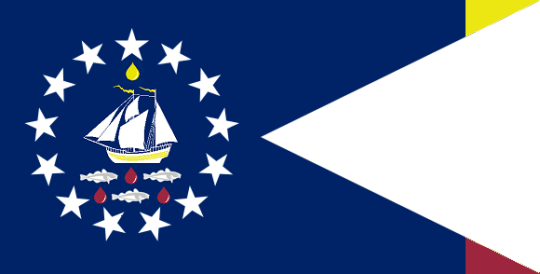
The Town of Innsmouth is a small fishing port in east-central Massachusetts with a troubled history.
Founded during the Jacobean Era at the mouth of the Manuxet River, it grew gradually through the 18th century into a mercantile hub, at its height sending ships to ports throughout China, India, and the South Pacific Islands and developing a diverse local culture.
This resulted in occasionally violent social conflict with its neighbors in a very protestant and racist region of rural New England. In the 1840s a wave of hysteria swept through the surrounding towns due to a minor outbreak of fever, and the epidemic was blamed on Pacific immigrants which had married into local families during the previous decade. The economy was devastated by the destruction and rioting which followed, though the event is largely forgotten.
As the Asia-Pacific trade routes began to wane in the mid-19th century, the town contracted and returned to its traditional fishing, which itself faded into obsolescence due to the much larger industrial-scale operations out of the major cities.
The local land-owning elites which had grown rich during the age of mercantile sailing tried to reorient the town to light industry, finding some success in precious metals refinery due to their connections with the Malay gold trade from the late 18th century. At the same time, there was a resurgence of the Innsmouth fishing industry due to uncommonly rich yields throughout the late 19th century and into the 20th.
Around this time, the city embraced a peculiar local religious denomination centered around a pagan veneration of the sea and fishing, which emerged during the age of the Pacific trade out of the local masonic lodge and the maritime methodist and baptist churches. Its existence contributed to decades of animosity between Innsmouth and the surrounding region.
A small boom of new commercial development followed, and a branch railroad was built connecting Innsmouth to its inland neighbors formerly cut off due to the thick wetlands surrounding the Manuxet River. The streets were paved during this time and electric lighting was installed. The population began to grow as migrants from the south settled there to find work in the emerging industries surrounding the refineries and Innsmouth was nearly incorporated as a city.
A series of murders and bombings during the 1920s hit the community hard and many people were left homeless or fled, resulting in a persistent decline which continues to this day. Furthermore, Innsmouth was a center of rum smuggling and speakeasy culture during the Prohibition Era, and the town was dealt a harsh blow by a major FBI raid in 1927 which shut down the Marsh Gold Refinery due to extensive connections with the illegal liquor trade.
Innsmouth was left with very little commerce. All that remained were the unprofitable fishing industry and a tiny service economy centered on a grocery store, a few restaurants, bars which reopened following the repeal of prohibition, and a hotel. There are no colleges or high schools, and much of its youth has migrated elsewhere since the 1940s. The town's aging population currently stands at 1,173.
The Civic Flag of Innsmouth was designed in 1953 by 58 year old local resident Eber Gilman to celebrate the town's tricentennial that year, and was adopted officially in 1960. It reflects the area's mercantile history as well as its ubiquitous fishing culture and gradual revival.
On a blue field in the center of thirteen white stars it features a brigantine sailing ship with yellow banners, representing wealth and good fortune. Beneath the ship are three white cod emblematic of the fishing industry. Checkered against the three cod are three droplets of red blood, which represent the Revolutionary War, the War of 1812, and the American Civil War in which the town sent sailors to privateer and soldiers to enlist in the federal army.
Over the mast of the ship is a bright yellow droplet, which represents the historical gold refining industry, as well as the the bright yellow moonlight which shines over the harbor. The flag is 1:2 in aspect ratio, and the fly ends in a swallowtail which begins at the center-point. The upper tip of the swallowtail is colored yellow, representing gold and wealth, while the lower tip is in red, representing toil and struggle. Together they represent the dual nature of the town's heart.
Hopefully in the future more awareness will be directed at the plight of rural towns across the United States which have been in a slow process of death for the last two centuries due to the concentration of industry in the larger cities, leaving traditional sources of revenue obsolete and unprofitable. Innsmouth's story reflects a history of poverty, racism, loss, and perseverance which has shaped the American working class.
2 notes
·
View notes
Text
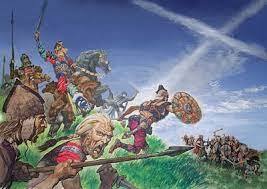

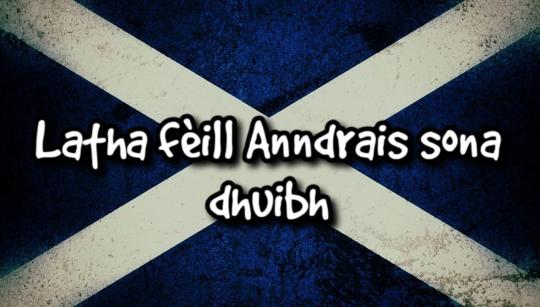
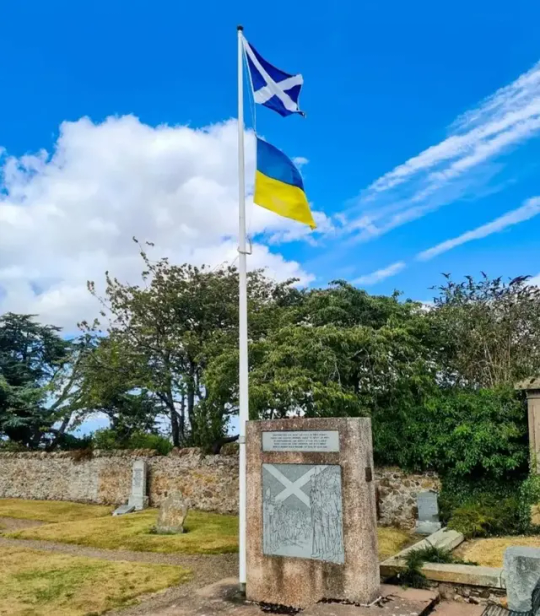


Happy St Andrews Day.
As part of our Patron Saint’s Feast Day the Scottish Saltire is proudly flown and many people add it to their posts on social media to celebrate the day, but how did Scotland adopt the saltire?
There is no actual date, or in fact nothing in our written history of the time, but legend has it that in AD 832 the king of the Picts, ‘Aengus MacFergus’, ( Anglified to Angus but some stories say Hungus) with the support of 'Scots’ from Dalriada, won a great battle against King Athelstane of the Northumbrians. The site of the legendary battle became known as Athelstaneford in present-day East Lothian.
St Andrew visited the Pictish leader in a dream before the battle and told him that victory would be won. When the battle itself was raging, a miraculous vision of the St Andrew’s Cross was seen shining in the sky, giving a boost to the morale and fighting spirit of his warriors. The result was a victory over the Saxons, and the death of Athelstan. Thus, after this victory, according to the tradition, the Saltire or St Andrew’s Cross became the flag of Scotland, and St Andrew the national patron saint.
While there is no written reference to the battle in Scotland from the period it was said to have taken place, this is not surprising, as it was a time for which we have little or no documentation for anything. The earliest written mention of the Battle of Athelstaneford in Scottish history comes from years later in the newspapers of the day, if you follow my posts then you know I dip into these “Chronicles from time to time, the first one to mention Athelstaneford is the Scotichronicon, written by the Scottish historian Walter Bower.
The Scotichronicon has been described by some Scottish historians as a valuable source of historical information, especially for the times that were recent to him or within his own memory. But he also wrote about earlier times, and this included the battle at Athelstaneford.
Bower’s account includes the scene where Aengus MacFergus is visited by St Andrew in a dream before the battle. He was told that the cross of Christ would be carried before him by an angel, there was no mention of a St Andrew’s Cross in the sky in this version. It was in later accounts, from the 16th centuries onwards, that we have the description of an image of St Andrew’s Cross shining in the sky
Bower was writing in the early 1400s. The bitter and bloody struggle to retain Scotland’s independence was not just a recent memory but also a current reality for him. Parts of Scotland were still occupied by England, and Bower had been involved in raising the money to release Scotland’s king, James I, from English captivity.
Also, Scotland’s early historical records and documents had been deliberately destroyed during the invasion by the English king Edward I. This was done in part as an attempt to remove historical evidence that Scotland had been an independent kingdom. The idea was simple: take away a nation’s history and you strip it of its identity and justification for its independent existence. The theft of the Stone of Destiny was part of this process, the Black Rood which was believed to contain a piece of the Cross Jesus was crucified on was also removed, I have covered both these in previous posts.
Part of Bower’s motivation in writing his Scotichronicon was to help restore this stolen history. He was a scholar and a man of the church. In his time, the figure of St Andrew had become a prominent presence in Scottish society.
The greatest church building in the land during his time was the Cathedral of St Andrew, which housed relics of St Andrew himself. It had taken over a hundred years to build and wasn’t formally consecrated until 1318, just four years after Bannockburn. The ceremony of course included Robert the Bruce and at it thanks was given to St Andrew for Scotland’s victory.
Less than 100 years after this, in 1413, the University of St Andrews was established and Walter Bower was one of its first students. By this time, the Cathedral of St Andrew was a place of pilgrimage, with thousands travelling there to venerate the saint’s relics. A pilgrimage route from the south took in the shrine of Our Lady at Whitekirk, not far from the site of the battle, and many pilgrims took a ferry across the Firth from North Berwick, where the ruins and remains of the old St Andrew’s Kirk can still be seen close to the Scottish Seabird Centre.
So as he sat down to write his history of earlier times, he was able to trace this connection to St Andrew, using the limited earlier written accounts, such as those of earlier Chronicler I’ve mentioned before, John Fordun, who lived in the 1300s. While Fordun doesn’t specifically mention the location of Athelstaneford, he records a battle which took place between the Picts led by Aengus and a force from the south led by Athelstan, and said the location of the battle was about two miles from Haddington. The account of St Andrew appearing in a dream to Aengus is also described by Fordun.
This creates a powerful link to the development of the written version of the story. Let’s remember Bower came from what is now East Lothian. Let us also remember that people in the early centuries stored and passed on much of their historical knowledge not in the written word but in memory and handed down oral traditions. People told stories, remembered them and told them to the next generation. Undeniably, some details would be forgotten or changed over time, but the bones of the story would be handed down. And that would include reference to locations of significant events in the local landscape.
Bower will have had access to this rich oral tradition of local stories based on handed-down collective memories of past events, which is perhaps why he was able to name the location. The later writers who added to the story of the battle will likewise have found new sources in the oral tradition to add to the narrative. Even in the 19th century, cartographers mapping the area were able to identify locations traditionally associated with the battle from local people who were custodians of ancestral memory.
This is how the story of the Battle of Athelstaneford and its connection with St Andrew and the Saltire has evolved.
The village is home to the National Flag Heritage Centre which occupies a lectern doocot built in 1583 and rebuilt in 1996. It is at the back of the village church. Today the village is surrounded by farmland and has little in the way of amenities. Tourists can follow the "Saltire Trail", a road route which passes by various local landmarks and places of historical interest.
Athelstaneford Parish Kirk has a connection with the subject of my post last week, author Nigel Tranter, who was a prominent supporter of the Scottish Flag Trust. He married in the church, and in April 2008 a permanent exhibition of his memorabilia was mounted in the north transept of the church. Items include a copy of Nigel Tranter's old typewriter, a collection of manuscripts and books, and other personal items. The display was previously at Lennoxlove House, and prior to that at Abbotsford House, the home of Sir Walter Scott.
27 notes
·
View notes
Text
How Insurance Companies Can Improve Data-Driven Decision Making

Introduction
Today’s insurance industry is under pressure to make faster, smarter decisions especially when customer expectations, competition, and risk variables are evolving constantly. The traditional models of relying solely on manual analysis or siloed systems no longer meet the demands of modern operations.
In this blog, we explore how insurers can improve data-driven decision-making by adopting the right tools, building a culture of insight-led action, and embracing platforms designed to support smarter, faster operations.
Why Data-Driven Decisions Matter in Insurance
Accurate decisions in underwriting, claims, and policy pricing all depend on the quality and accessibility of data. Insurance companies collect vast volumes of data every day from customer behaviour and claims history to real-time risk inputs. But if this data isn't integrated or actionable, it offers little value.
That’s where a digital insurance platform plays a key role. When insurers move to centralised systems with connected workflows, they gain a real-time view of customer needs, risk factors, and operational performance all of which are essential for informed decision-making.
What Makes a Data-Driven Insurance System Work?
A truly data-driven insurance business doesn’t just collect data; it turns that data into action. This requires more than just dashboards it involves the full integration of systems, platforms, and teams.
At the heart of it is an insurance software company that delivers the foundation. With an intelligent platform, insurers can unify data across underwriting, claims, customer service, and compliance giving every department access to consistent, real-time information.
Benefits of a Data-Driven Approach for Insurers
1. Improved Risk Assessment
By using historical and real-time data, insurers can better predict risk and make more accurate pricing decisions. This leads to fewer losses and more sustainable product offerings.
2. Faster and More Accurate Claims Handling
Data-driven systems reduce manual steps and automate validations. Claims can be reviewed, approved, or flagged in a matter of minutes enhancing customer trust and operational efficiency.
3. Personalised Product Development
When data is used to understand customer preferences and buying patterns, insurers can create products that are more relevant and offer greater value leading to improved conversion and retention.
4. Better Regulatory Compliance
Tracking and reporting requirements are easier to manage when data is organised and auditable. A good system supports real-time compliance with local standards like POPIA.
Strategies to Improve Data-Driven Decision-Making
1. Invest in a Scalable Digital Insurance Platform
Look for platforms that support API integrations, real-time analytics, and automation. This ensures that your decision-making process is supported by the right technology from end to end.
2. Train Teams to Interpret and Apply Insights
It’s not just about the data it’s about how teams use it. Encourage cross-functional training so that underwriters, claims specialists, and service reps can make informed decisions based on data.
3. Prioritise Data Quality and Governance
Ensure that all departments input clean, consistent data. The value of a digital ecosystem depends on the accuracy and reliability of the information flowing through it.
Conclusion
Data-driven decision-making is not just a competitive advantage—it’s becoming the standard for forward-looking insurers. By adopting the right insurance digital transformation tools and practices, insurers can simplify complex operations, improve customer outcomes, and respond faster to market needs.
Whether you're looking to optimise risk, automate claims, or improve customer engagement, choosing the right insurance software company and platform is the first step toward smarter business decisions.
0 notes
Text
What Has Your Crypto Touched?
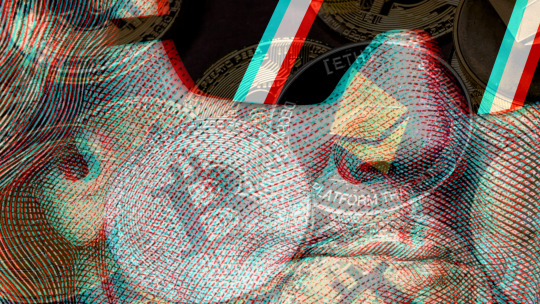
Cryptocurrency has long been a target of scrutiny by traditional financial institutions, with banks frequently closing accounts that interact with digital assets. This isn’t just paranoia or anti-crypto sentiment — it’s about risk management, compliance, and the global effort to control illicit financial flows.
Banks operate under the oversight of the FDIC and other regulatory bodies, which demand strict adherence to anti-money laundering (AML) and know-your-customer (KYC) regulations. The U.S. government has made it clear that it prioritizes tracking financial transactions to prevent terrorism financing, human trafficking, and drug manufacturing.
When a bank detects cryptocurrency activity, the reaction isn’t about a bias against crypto — it’s about minimizing regulatory exposure and legal liability. Imagine this scenario: You’re HODLing Bitcoin that has passed through a wallet flagged as belonging to ISIS. You had no idea, and perhaps the person you bought it from didn’t either. But that Bitcoin’s history is now tied to illicit activity. From a compliance perspective, this presents a major problem. Regulators expect financial institutions to maintain strict oversight on funds flowing through their systems. Instead of trying to track every individual wallet that ever transacted with a blacklisted address, it’s far easier for regulators to clamp down at the source — the banks.
This is more than just a hypothetical concern — banks operate with extreme caution when it comes to regulatory risk. If an account exhibits repeated crypto transactions, it introduces an element of uncertainty. Is the customer buying crypto on a legitimate exchange? Are they inadvertently funneling funds through a tainted wallet? Rather than take the chance, banks often choose the simplest solution: shut down the account and remove the risk altogether.
For individuals, this crackdown has had real consequences. Many crypto users — including myself — have been blindsided by sudden account freezes or closures, forcing us to scramble for alternatives. I personally had a bank account closed in the past due to crypto transactions, despite following all legal and compliance guidelines. This experience highlighted just how little control individuals have when financial institutions decide that crypto exposure is too risky. It was a wake-up call that even those who play by the rules can find themselves cut off from the banking system without warning.
With regulators tightening their grip and financial institutions unwilling to take unnecessary risks, crypto must adapt to regulatory realities or risk being sidelined or reshaped by mainstream finance. The solution isn’t to ban blockchain — it’s to evolve it into a system that aligns with regulatory frameworks while maintaining its efficiency. Governments and financial institutions are moving toward blockchain-based digital currencies with built-in compliance measures.
This shift will enable regulators to merge blockchain efficiency with KYC and AML safeguards, creating a system that works with traditional finance rather than against it. We’re already seeing this trend take shape with regulated and institutional-grade stablecoins as the bridge between blockchain technology and traditional finance.
For crypto purists, this may sound like an attack on decentralization. But the reality is that large-scale financial adoption will only happen within a regulatory framework. The days of completely unregulated digital currencies are numbered — not because the technology is flawed, but because financial institutions will always default to the path of least risk.
The rules are shifting, and those who adapt will thrive. Where do you stand?
0 notes
Text



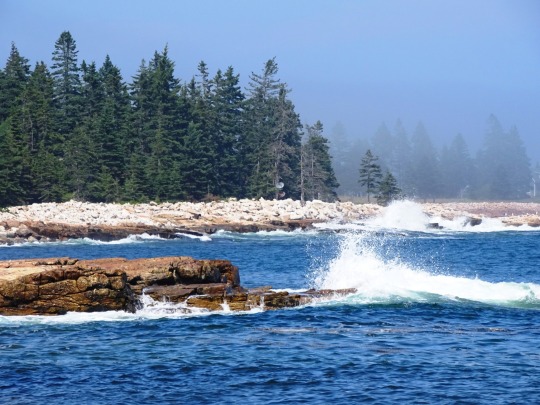



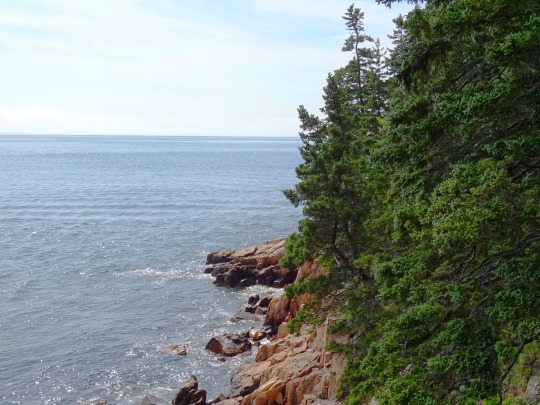


National Acadian Day
Every year, certain Canadian regions commemorate National Acadian Day on August 15 to honor the Acadian people and culture. The Acadian leaders were given the mandate to designate the date of this celebration, which is also the feast of the Assumption of Mary, during the first National Convention of the Acadians in Memramcook, New Brunswick, in 1881. The Acadians, who originated in France, were the first Europeans to permanently settle in Canada.
History of National Acadian Day
The history and culture of Canada’s Acadian people are commemorated on National Acadian Day. When France founded Nova Scotia in Port Royal in 1605 as North America’s first permanent settlement, thousands of Acadians were compelled to abandon their homes and relocate as a result of the Great Upheaval, which lasted from 1755 to 1763. Many people eventually returned to the Acadian region, but others never did.
National Acadian Day was founded in 1881 at the first National Convention of the Acadians in Memramcook, New Brunswick, when the Acadian leaders were given the task of deciding on a date for the celebration, which coincided with the Assumption of Mary’s feast day. The date was the subject of a debate at the convention between those who wanted Acadians to commemorate Saint-Jean-Baptiste Day, which has been a national day of French Canadians since 1834 and a national holiday of Quebec since 1977, on June 24, and those who wanted the commemoration to take place on August 15.
During this time, a significant number of Acadian leaders were traditionalists who desired the preservation of pre-revolutionary France’s ideals and practices. This did not stop the Acadians from adopting a tricolor flag at the Miscouche convention three years later. With his statement before the conference, Abbot Marcel-François Richard, who supported August 15, is thought to have influenced the outcome. By January 1938, the Vatican approved the Acadian convention’s choice in a declaration. National Acadian Day became an official Canadian holiday in 2003, thanks to the efforts of the Canadian Parliament.
National Acadian Day timeline
1881 The First Acadian Day
National Acadian Day is established at the first National Convention of the Acadians.
1994 First Congrès Mondial Acadien (C.M.A.)
The first Congrès Mondial Acadien (C.M.A.) is held across municipalities in Southeastern New Brunswick.
2003 Royal Recognition
A Royal Proclamation recognizes the wrongs suffered by the Acadians when they were forcibly deported from Acadie from 1755 until 1762.
2004 National Acadian Day
The provincial governments officially recognize National Acadian Day.
National Acadian Day FAQs
Can you see the Northern Lights in Acadia?
The Northern Lights can often be observed from Downeast Acadia’s northernmost reaches.
Is Acadia home to bears?
On the island, there is a small permanent population of black bears.
Can you go hiking at night in Acadia?
Acadia National Park’s Park Loop Road is open at night, allowing visitors to drive into and around the park.
National Acadian Day Activities
Make plans to visit Acadia
Read about Acadian history
Listen to music from Acadia
Festivals are held by Acadians to celebrate their centuries-old traditions, as well as contemporary arts and culture. Festivals are held all year in Acadian and francophone towns around the province, so plan a vacation to Canada to see them for yourself.
It's possible that you've never heard of Acadia, a French colony in North America. Now that you've heard of them, it's time to learn more about their culture and history for yourself!
Good music has a way of burying itself in our hearts. It's something that brings us all together. Listen to Acadian music or Google up and listen to Acadian artists.
5 Facts About Acadia That Will Blow Your Mind
Acadia's first capital
Bolognino Zaltieri
The inspiration behind Acadia
Cod abundance
The Acadian dialect
Port Royal was Acadia's first capital and was erected in 1605.
Bolognino Zaltieri named an area far to the northeast of present-day Nova Scotia and New Brunswick 'Arcadia' in 1566.
The term ’Quoddy,’ which means open sloop-rigged sailboat, was thought to have inspired the name Acadia.
Acadia was famed for its abundance of cod, which drew European traders and fishermen to its shores.
Chiac is an Acadian dialect prevalent throughout the region.
Why We Love National Acadian Day
The view from Otter Cliff
Being one with nature
It commemorates Acadia's past
Otter Cliff, at 110 feet above sea level, is the spectacular climax of the Ocean Walk. It's a popular rock climbing destination, and it's composed of Cadillac granite, the unique pink rock that Acadia is known for.
Acadia is all about taking in the beauty of nature, and camping and stargazing add to the experience. The park campgrounds are inexpensive, nice, and clean, even if they are a little run-down.
Acadians' history is commemorated on National Acadian Day. It honors their history and culture while also preserving their legacy.
Source
#Acadia National Park#Grand Falls#New Brunswick#Shediac#vacation#USA#Acadia Memorial#Croix de la departion#Halifax#Nova Scotia#2018#summer 2015#original photography#cityscape#architecture#public art#National Acadian Day#15 August#NationalAcadianDay#Atlantic Ocean#Maine#landscape#seascape#beach#Acadian flag#flora#nature#forest#pond#Canadian history
8 notes
·
View notes
Text
Celebrating 76 Years of Indian Democracy: Happy Republic Day January 26 - 2025

As we approach the 76th Republic Day on January 26, 2025, India stands poised to celebrate a momentous milestone in its democratic journey. This day marks not just another year of constitutional governance, but a testament to the enduring spirit of unity, democracy, and freedom that defines our great nation.
The Significance of Republic Day
Republic Day holds a special place in the hearts of all Indians. It commemorates the day when the Constitution of India came into effect in 1950, marking the country's transition from a British dominion to a sovereign republic. This historic event was the culmination of years of struggle, sacrifice, and unwavering determination of countless patriots who dreamed of a free and democratic India.
The adoption of the Constitution was a pivotal moment that laid the foundation for India's governance, ensuring fundamental rights, justice, and equality for all citizens. It's a day that reminds us of the values and principles that guide our nation and the responsibility we bear to uphold them.
A Journey Through Time: India's Constitutional History
To truly appreciate the significance of Republic Day, it's essential to understand the journey that led to this historic moment:
Independence and the Constituent Assembly: After gaining independence in 1947, the task of drafting a constitution for the newly free nation began.
Drafting Process: The Constituent Assembly, led by Dr. B.R. Ambedkar, worked tirelessly for nearly three years to craft a constitution that would reflect India's diverse needs and aspirations.
Adoption of the Constitution: On November 26, 1949, the Constitution was adopted by the Constituent Assembly.
Implementation: The Constitution came into effect on January 26, 1950, chosen to coincide with the anniversary of the Declaration of Indian Independence (Purna Swaraj) of 1930.
This journey showcases the dedication and foresight of India's founding fathers in establishing a democratic framework that has stood the test of time.
Celebrating Unity in Diversity
One of the most remarkable aspects of India's republic is its ability to maintain unity amidst incredible diversity. With 28 states and 8 union territories, India is home to a multitude of languages, religions, cultures, and traditions. The Constitution of India recognizes and protects this diversity while providing a common framework of governance.
As we celebrate the 76th Republic Day, it's crucial to reflect on how this unity in diversity has been a source of strength for the nation. Some key aspects include:
Linguistic Diversity: India recognizes 22 official languages, with hundreds more spoken across the country.
Religious Harmony: The secular nature of the Indian Constitution ensures freedom of religion for all citizens.
Cultural Richness: From art and music to cuisine and festivals, India's cultural tapestry is unparalleled.
This diversity is not just a feature of Indian society; it's a core strength that has contributed to the nation's resilience and growth over the years.
The Republic Day Parade: A Symbol of National Pride
No discussion of Republic Day is complete without mentioning the grand parade held in New Delhi. This spectacular event showcases India's cultural heritage, military might, and technological advancements. Key highlights of the parade include:
Presidential Arrival: The ceremony begins with the arrival of the President of India, who is also the Commander-in-Chief of the Indian Armed Forces.
Unfurling of the National Flag: The President unfurls the national flag as the national anthem is played, followed by a 21-gun salute.
Military Displays: Various regiments of the Indian Armed Forces, paramilitary forces, and police forces march in all their finery.
State Tableaux: Colorful floats representing different states and union territories showcase India's cultural diversity.
Cultural Performances: Folk dances and music from various parts of the country are presented.
Flypast: The Indian Air Force concludes the parade with a breathtaking aerial display.
The parade is not just a display of India's strengths but also a reminder of the collective responsibility we share in nation-building.
Upholding Constitutional Values in Modern India
As we celebrate 76 years of being a republic, it's crucial to reflect on how we can continue to uphold the values enshrined in our Constitution. In an ever-changing world, the principles of justice, liberty, equality, and fraternity remain as relevant as ever.
Some ways we can embody these values in our daily lives include:
Promoting Education: Education is key to empowering citizens and ensuring they can fully participate in democratic processes.
Advocating for Social Justice: Working towards eliminating discrimination and promoting equality for all.
Participating in Civic Duties: Actively engaging in democratic processes, from voting to community service.
Protecting the Environment: Recognizing our duty to preserve the nation's natural resources for future generations.
Fostering Innovation: Encouraging scientific temper and the spirit of inquiry to drive progress.
By actively engaging with these principles, we contribute to the strengthening of our democratic fabric.
Dr. Nowhera Shaik's Message: Embracing Our Shared Heritage
Dr. Nowhera Shaik, MD & CEO of Heera Group of Companies, shares a powerful message on this 76th Republic Day:
"As we commemorate this auspicious occasion, let us pledge to uphold the ideals of our Constitution and strengthen the Unity in Diversity that makes India truly unique. Jai Hind! Warm greetings to all Indians on the 76th Republic Day."
Dr. Shaik's words remind us of the importance of coming together as a nation, transcending our individual differences to celebrate our shared heritage and common future. Her call to uphold constitutional ideals echoes the responsibility each citizen bears in preserving and strengthening India's democratic foundations.
Looking Ahead: India's Future as a Republic
As we celebrate 76 years of being a republic, it's natural to look ahead and envision India's future. The country stands at a crucial juncture, with immense potential and challenges ahead:
Technological Advancements: India's growing IT sector and digital initiatives promise to revolutionize governance and citizen services.
Economic Growth: Continued focus on economic reforms and entrepreneurship is key to India's global economic standing.
Environmental Sustainability: Balancing development with environmental protection will be crucial for sustainable growth.
Social Progress: Ongoing efforts to address social inequalities and promote inclusive development remain a priority.
Global Leadership: India's role on the world stage continues to evolve, with opportunities for greater influence in global affairs.
As we move forward, the principles laid down in our Constitution will continue to guide us, ensuring that progress is inclusive, sustainable, and in harmony with our democratic values.
Learn more about India's constitutional history
As we conclude our reflection on India's 76th Republic Day, let's reaffirm our commitment to the ideals that have shaped our nation. The spirit of unity, democracy, and freedom that Dr. Nowhera Shaik speaks of is not just a legacy of our past but a guiding light for our future. Let each of us play our part in building a stronger, more inclusive India. Jai Hind!
#republicday2025#nowherashaik#heeragroup#indianconstitution#unityindiversity#jaihind#indiandemocracy#freedomstruggle#indianculture#indianheritage#constitutionalvalues#indianindependence#nationalpride#republicdayparade#indianflag#tricolor#indianhistory#celebrateindia#proudindian#constitutionday#drnowherashaik#youtube#hyderabadproperty
0 notes
Text
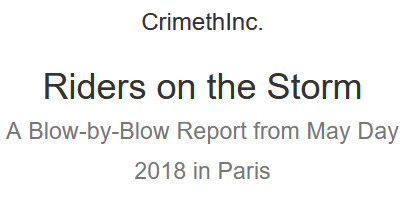
Background: 127 Years of History
May Day is observed as International Workers’ Day in France, as it is in many other countries. For more than a century, workers, trade unionists, traditional leftists, and anarchists have demonstrated together or separately to pay tribute to the struggles of the late 19th century and the introduction of the eight-hour workday.
Yet May Day has never been limited to legal demonstrations. On May 1, 1891, in Fourmies, soldiers shot at striking workers, killing nine people—including four under the age of 18—and injuring 35 more. Afterwards, a crowd took the streets of Clichy brandishing a red flag. At the end of the demonstration, police attempted to seize the revolutionary emblem, provoking a riot. Gunshots echoed in the streets and some policemen were injured. Three anarchists were arrested and detained. Tried in August 1891, the defendants were sentenced to up to 5 years in prison. These events awoke the convictions of many future radicals, including the notorious anarchist François Koënigstein, better known by his nickname, Ravachol.
In France, May Day also has other connotations. In 1941, aiming to force a rupture with socialism, Marshal Pétain—fervent anti-Semite, head of the French government during the occupation, and among those chiefly responsible for state collaboration with the Nazis—passed legislation declaring that May Day would be called la Fête du Travail et de la Concorde Sociale (“the day of labor and social harmony”). Since then, Labor Day in France continues to bear the name “Fête du Travail,” paying tribute to Pétain’s maxim ”Travail, Famille, Patrie” (“Work, Family, Fatherland”).
During the 1950s and 1960s, Labor Day disappeared in France. During the war in Indochina (1946–1954) and the Algerian War of Independence (1954–1962), successive French governments seeking to preserve their colonial holdings instituted a State of Emergency (1955-1958-1961). The state used this “exceptional” law granting special powers to the executive branch to forbid demonstrations of all kinds in France. It was only on May 1, 1968 that people in France were once again able to take the streets to celebrate Labor Day.
More recently, in 2016 and 2017, anarchists and other autonomous rebels succeeded in taking the front of the afternoon May Day demonstration, relegating trade unions and political parties to the end of the procession. By adopting an offensive strategy—attacking every single potential target on our route—we brought new life to the demonstration, interrupting the ritual it had become.
As we approached May Day 2018, we faced a new challenge. Once again, we had to rewrite the story.
#analysis#France#May Day#Paris#labor#may 1st#anarchism#resistance#autonomy#revolution#community building#practical anarchism#anarchist society#practical#anarchy#daily posts#communism#anti capitalist#anti capitalism#late stage capitalism#organization#grassroots#grass roots#anarchists#libraries#leftism#social issues#economics#anarchy works#environmentalism
3 notes
·
View notes